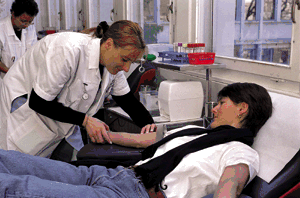Donation
 |
Whole blood donation
Source: HUG |
|
The different types of donation
- Whole blood donation: an average of 450 ml of blood is taken from the vein located on the fold of the elbow, in a bag containing anticoagulant solution. Collection time is about 10 minutes.
- Platelets donation (thrombapheresis): an average of 200 to 300 ml of mix a mix of platelets and plasma is taken from the vein located on the fold of the elbow. The blood is separated into plasma and platelets and the rest of the blood (red cells and part of plasma) is reinfused into the donor. This is performed in a sterile single use plastic kit placed in an aphaeresis machine.
- Plasma donation (plasmapheresis): an average of of 400 to 600 ml is taken from the vein located on the fold of the elbow. Whole blood is treated in an aphaeresis machine which collects only plasma and restores directly the rest of the blood (red cells and platelets) to the donor.
 |
Thrombapheresis
Source: HUG |
|
Criteria of donation
Every healthy individual, aged between 18 and 65, may give his/her blood (women 3 times a year and men 4 to 5 times a year). Before each donation, the donor is checked for its weight (which must be above 50 Kg), pulse, blood pressure and hemoglobin level. A physician, or a trained nurse in some countries, asks multiple specific questions in order to evaluate eligibility of the donor.
|




 Print
Print